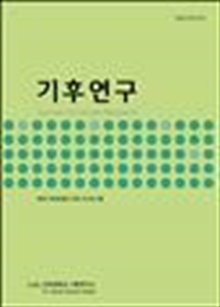간행물
기후연구 KCI 등재 Journal of Climate Research

- 발행기관 건국대학교 기후연구소
- 자료유형 학술지
- 간기 계간
- ISSN 1975-6151 (Print)2288-8772 (Online)
- 수록기간 2006 ~ 2021
- 주제분류 사회과학 > 지리학 사회과학 분류의 다른 간행물
- 십진분류KDC 453DDC 551
권호리스트/논문검색
제12권 제4호 (2017년 12월) 5건
1.
2017.12
서비스 종료(열람 제한)
The purpose of this paper is three-fold: to analyze the macrotrend of North Korea’s food supply and demand; to confirm the food security situation in North Korea in various respects; and to seek the sustainable ways of agricultural production as a prerequisite for food security in North Korea. In particular, analyzing North Korea’s weather observation data, which has hardly been considered in previous studies, we investigated how North Korea’s agriculture had been affected by various natural disasters (flood, drought, soil loss etc.) caused by unusual weather. The results show the fact that the agricultural security systems of North Korea is vulnerable to both drought and flood due to extreme precipitation changes, which are closely related to the negative impacts on North Korea’s agricultural activities. In order to enhance the sustainability of North Korea’s agriculture, it is necessary to improve the system (dissolution of collectivization), increase the amount of agricultural materials, enhance soil fertility and develop agricultural machines. Most of all, this research reveals the fact that the most important and fundamental points for food security in North Korea, it needs the systematic strategies to cope with climate change.
2.
2017.12
서비스 종료(열람 제한)
Persistent Extreme Temperature Events (PETEs) are defined in two steps; first, to define extreme temperature events, the 80th and 20th percentiles of daily maximum and minimum temperature were chosen. Then individual PETE was defined as an event which lasted three or longer consecutive extreme temperature days. In this study, we examined characteristics and changes of PETEs in Republic of Korea (ROK) using 14 weather stations with a relatively long-term period of data, 1954-2016. In ROK, PETEs lasted four-five days on average and occurred two-three times a year. PETEs lasted longer in summer than in winter and in maximum temperature than in minimum temperature. PETEs which lasted greater than seven days account for a greater proportion in summer than in winter. However, intensities of PETEs were greater in winter because of a larger temperature fluctuation. In both summer and winter, durations and intensities of persistent extreme high temperature events increased while those of persistent extreme low temperature events decreased. Changes of PETEs were closely related with both global warming and diverse large-scale climate variabilities such as AO, NAO and Nino 3.4.
3.
2017.12
서비스 종료(열람 제한)
This study analyzes relationship between land cover change and local climate data of 46 weather stations in South Korea from the 1980s to 2000s. The used area shows proportional relationships to mean daily min. temperature and mean temperature, and a reverse relationship is found between the used area and relative humidity. However, the forest indicates reverse relationships to mean daily min. temperature and mean temperature. The agricultural land causes to increase in relative humidity and decrease in mean wind speed, while the water increases mean daily min. temperature, daily min. temperature and mean temperature as well as mean wind speed. The urbanization type (used area + barren) shows high correlations with temperature and humidity. The suburbanization type (agricultural land + forest + grass + wetland) has high correlations with temperature and wind speed. High correlations are also found between the waterfront type (wetland + water), and temperature and wind speed. It can be concluded that change in land cover around weather station obviously influences on climate data of the weather station and it is also expected that reliability and homogeneity of climate data from a weather station can be enhanced by this study.
4.
2017.12
서비스 종료(열람 제한)
In this study, a weighted ensemble method of numerical weather prediction by ensemble models is applied for PyeongChang area. The post-processing method takes into account combination and calibration of forecasts from different numerical models, assigning greater weight to ensemble models that exhibit the better performance. Three different numerical models, including European Center Medium-Range Weather Forecast, Ensemble Prediction System for Global, and Limited Area Ensemble Prediction System, were used to perform the post-processing method. We compared the model outputs from the weighed combination of ensembles with those from the Ensemble Model Output Statistics (EMOS) model for each raw ensemble model. The results showed that the weighted ensemble method can significantly improve the post-processing performance, compared to the raw ensemble method of the numerical models.
5.
2017.12
서비스 종료(열람 제한)
Prediction of Arctic Sea Ice Concentration of Kara-Barents Seas Using RCM Data with Machine Learning
Arctic sea ice as an indicator of climate change plays an important role in controlling global climate system. Thus, accurate observation and prediction of Sea Ice Concentration (SIC) is essential for understanding global climate change. In this study, we aim to improve the prediction accuracy of SIC by using machine learning and Regional Climate Model (RCM) data for a more robust method and a higher spatial resolution. Using the CORDEX RCM and NASA SIC data between January 1981 and December 2015, we developed three statistical models using Multiple Linear Regression (MLR), Support Vector Machine (SVM), and Deep Neural Network (DNN) which can deal with the non-linearity problem, respectively. The DNN model showed the best performance among the three models with the significant correlation between the predictive and observed SIC (r=0.811, p-value < 0.01)and the Root Mean Square Error (RMSE) of 0.258. With deeper considerations of the polar fronts and the characteristics of ocean current and tide, the DNN model can be applied for near future prediction of Arctic sea ice changes.

